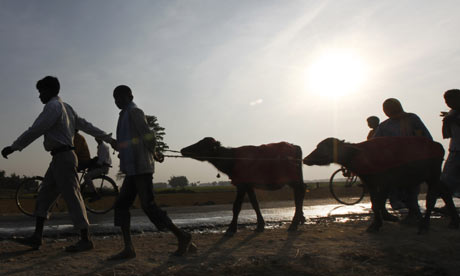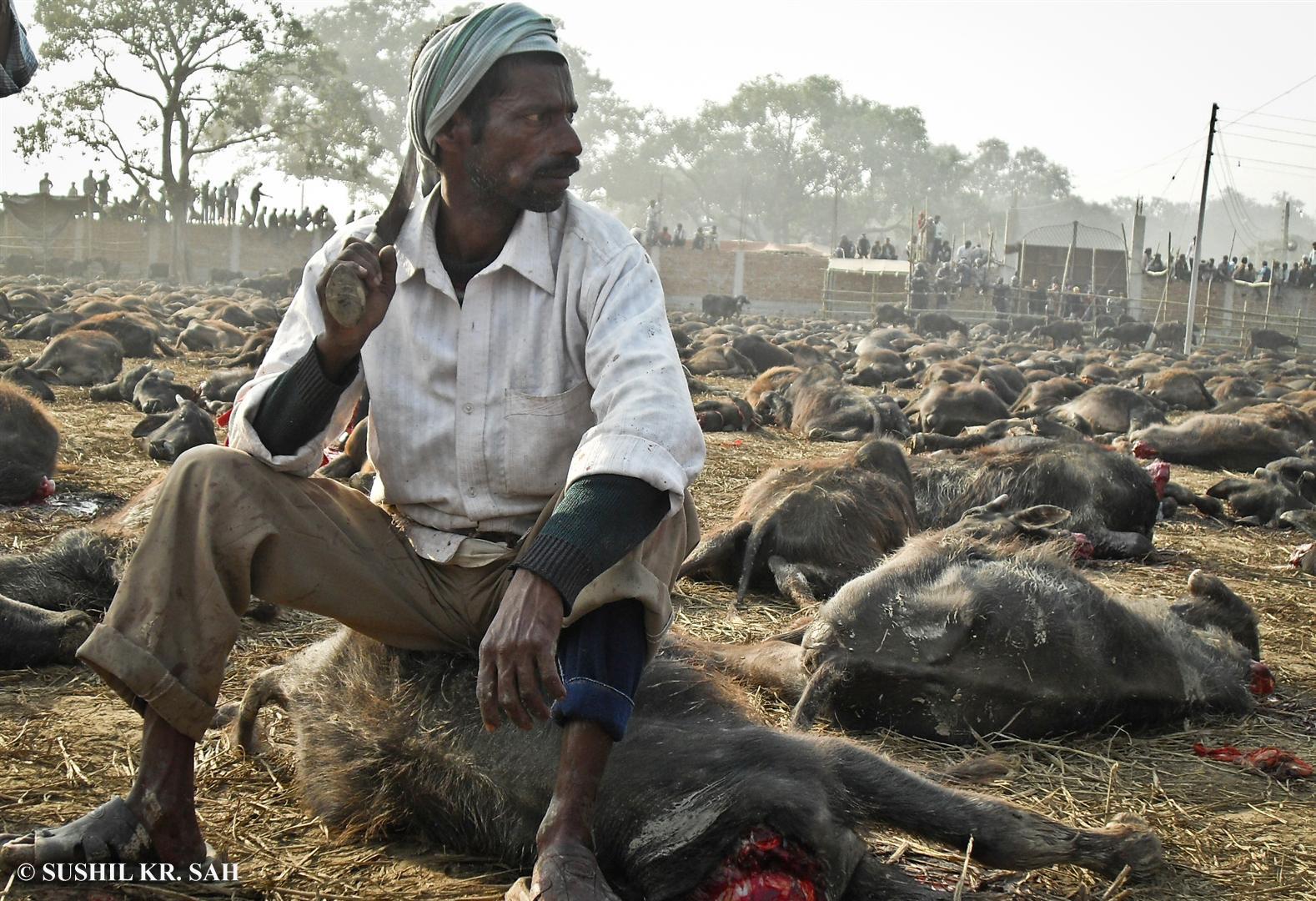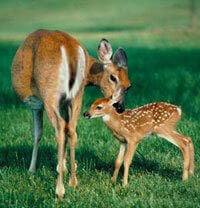“The fear and dread of you shall rest on every animal of the earth, and on every bird of the air, on everything that creeps on the ground, and on all the fish in the sea; into your hand they are delivered. Every moving thing that lives shall be food for you; and just as I gave you the green plants, I give you everything.’” —Genesis
As long as lip service is paid to religions that legitimize animal abuse, in all its forms: Judaism, Christianity and Islam, we will be picking up after the destruction of those who preach and live by dominion.Hunting as it exists in Christian nations, is against the law in India, where a more benign view of animals allows for man to co-exist with, rather then destroy them on a whim.
Hunting enriches many constituencies: arms and ammunition manufacturers (the chief industrial support for the NRA); “outdoors riggers”, hunting and travel guides, lodging and accommodation providers, hunting publications (many masquerading as “outdoors” magazines), and outfitters of all kinds.
•
The below information is a sampler of the many opportunistic merchants of death catering to the depraved clientele of rich (mostly white) psychopaths intent on “bagging” an elephant or other scarce majestic animal. In a truly civilized society they would be outlawed, period. And probably punished, severely. As would their customers. But we don’t live in such a nation or nations for that matter, not even by far. Money still calls the shots, literally, and the animals pay with their lives. We live in a huge bubble of self-approving hypocrisy.
•
Note how the outfitters and guides advertising below start their sale with an outright lie, that the elephant—among others—is not in any danger. Strong stomach required.
§
The anti-hunting community would like you to believe the elephant is endangered and on the verge of extinction. Facts however paint a very different picture.
There are in excess of 70,000 elephants in ONLY
Zimbabwe today – nearly double the amount of elephants that the environment has the capacity to support, so hunting is an important conservation tool.
No part of the elephant is ever wasted
Browse Our Elephant Hunting Safaris:
•
•
•
- Non-Trophy Elephant Hunts in Zimbabwe
- Elephant Hunts for Bulls Under 35lbs.
- …or Tuskless Elephant Hunts
- Unbeatable Price!
- Add Plains Game to Your Hunt
- June – September
- learn more | Ask about this hunt
African elephant hunting requires expert tracking. In addition, an elephant hunter must be prepared to walk great distances, for days on end, to secure a good tusker. The elephant is one of the most exciting trophies to hunt.
END OF SELF-SERVING, MORALLY TOXIC MATERIAL PROMOTING HUNTING
________________________________________
APPENDIX
The Skinny About Hunting
Hunting might have been necessary for human survival in prehistoric times, but today most hunters stalk and kill animals merely for the thrill of it, not out of necessity. This unnecessary, violent form of “entertainment” rips animal families apart and leaves countless animals orphaned or badly injured when hunters miss their targets.
Pain and Suffering
Quick kills are rare, and many animals suffer prolonged, painful deaths when hunters severely injure but fail to kill them.
A member of the Maine BowHunters Alliance estimates that 50 percent of animals who are shot with crossbows are wounded but not killed. A study of 80 radio-collared white-tailed deer found that of the 22 deer who had been shot with “traditional archery equipment,” 11 were wounded but not recovered by hunters.
A British study of deer hunting found that 11 percent of deer killed by hunters died only after being shot two or more times and that some wounded deer suffered for more than 15 minutes before dying.
Twenty percent of foxes wounded by hunters are shot again; 10 percent manage to escape, but “starvation is a likely fate” for them, according to one veterinarian.
Hunting also disrupts migration and hibernation patterns and destroys families. For animals such as wolves and geese, who mate for life and live in close-knit family units, hunting can devastate entire communities.
The fear and the inescapable, earsplitting noises from the gunfire and other commotion that hunters create cause hunted animals to suffer tremendous stress. This severely compromises their routine and their eating habits, making it hard for them to store the fat and energy that they need to survive the winter. Loud noises can also disrupt mating rituals and can cause parent animals to flee their dens and nests, leaving their young vulnerable to natural predators.
Hunting as Sport and ‘Fair Chase’
Hunting is often called a sport as a way to pass off a cruel, needless killing spree as a socially acceptable, wholesome activity. However, sports involve competition between two consenting parties and the mediation of a referee. And no sport ends with the deliberate death of one unwilling participant.
Some hunting groups claim that by obeying laws and killing free-range animals in a manner that does not give humans an “improper advantage” over their prey, the activity constitutes “fair chase.” Of course, these same groups encourage hunters to shoot game with rifles, shotguns, and bows and arrows—weapons that no animal has any chance of outrunning, let alone fighting. Furthermore, “free range” as defined today rarely implies the vast wilderness that large game once roamed.
Nature Takes Care of Its Own
Contrary to what hunters often say in defense of their cruel pastime, hunting has nothing to do with “conservation” or “population control.” In fact, animals are often specially bred and raised for hunters to kill.
If left unaltered by humans, the delicate balance of nature’s ecosystems ensures the survival of most species. Natural predators help maintain this balance by killing only the sickest and weakest individuals.
Hunters, however, strive to kill the animals they would like to hang over the fireplace—usually the largest, most robust animals, who are needed to keep the gene pool strong. This “trophy hunting” often weakens the rest of the species’ population: Elephant poaching is believed to have increased the number of tuskless animals in Africa, and in Canada, hunting has caused the bighorn sheep’s horn size to fall by 25 percent in the last 40 years. Nature magazine reports that “the effect on the populations’ genetics is probably deeper.”
Even when unusual natural occurrences cause overpopulation, natural processes work to stabilize the group. Starvation and disease are tragic, but they are nature’s way of ensuring that healthy, strong animals survive and maintain the strength of their herd or group. After hunters kill the largest members of a population, the offspring of weak adults have difficulty finding food and gaining the strength needed to survive extreme weather; therefore, hunting can actually cause starvation rather than prevent it.
“Sport” hunting also exacerbates other problems. For example, the transfer of captive-bred deer and elk between states so that hunters can kill them is believed to have contributed to the epidemic spread of chronic wasting disease (CWD), a fatal neurological illness in deer and elk that has been compared to mad cow disease. As a result, the U.S. Department of Agriculture (USDA) has given state wildlife agencies millions of dollars to “manage” deer and elk populations. While the USDA and the Centers for Disease Control and Prevention claim that CWD has no relationship to any similar diseases that affect humans or farmed animals, the slaughter of deer and elk continues.
Taking exotic “game” animals to non-native environments for hunters to kill is another problem: If they’re able to escape and thrive, they can pose a threat to native wildlife and disrupt established ecosystems.
Accidental Victims
Hunters’ intended targets aren’t the only ones who suffer. Hunting accidents destroy property and injure and kill horses, cows, dogs, cats, hikers, and other hunters. According to the International Hunter Education Association, there are dozens of deaths and hundreds of injuries attributed to hunting in the U.S. every year—and that number only includes incidents involving humans.
Bloodthirsty and Profit-Driven
Even though less than 5 percent of the U.S. population hunts, nonhunters are forced to share many wildlife refuges, national forests, state parks, and other public lands with armed individuals who enjoy killing animals. Almost 40 percent of hunters in the U.S. slaughter and maim millions of animals on public land every year. By some estimates, poachers kill just as many animals illegally. Most federal and state agencies that are charged with managing wildlife refuges, national forests, state parks, and other public lands are funded in part by hunting and fishing activities, so agency personnel often go out of their way to encourage these activities rather than regulate or police them.
To attract more hunters (and their money), federal and state agencies actively recruit children because they know that most people will never hunt if they aren’t exposed to it early in life. Some agencies have even convinced schools to offer hunting courses to young children. For folks who were not exposed to hunting at an early age, agencies and special interest groups hold events and support clubs that target people who are less likely to purchase licenses, such as women, racial minorities, and senior citizens. Wildlife agencies also know that hunters are more likely to purchase licenses in subsequent years if a previous hunt resulted in a kill. Therefore, they implement programs—often called “wildlife management” or “conservation” programs—that are designed to boost the number of “game” species. These programs help to ensure that there are plenty of animals for hunters to kill and, consequently, plenty of revenue from the sale of hunting licenses.
Because wildlife agencies are funded by excise taxes on hunting and fishing equipment and by revenue from the sale of licenses, hunters—who constitute a tiny percentage of Americans—enjoy a disproportionate say in how wild areas and the animals who inhabit them are managed. Because money talks, Americans who choose to participate in humane, nonlethal activities such as hiking and bird-watching are given little to no role in decisionmaking.
A Humane Alternative for Population Control
Hunters who claim that they kill deer to “control the population” are kidding themselves. The fact that there are 30 million deer in the U.S. despite years of hunting shows that killing animals is not an effective way to manage populations.
Some wildlife agencies are finally realizing this and are considering other management techniques. Some studies suggest that sterilization is an effective, long-term solution to overpopulation. A method called “trap, neuter, and return” has been tried on deer in Ithaca, New York, and an experimental birth-control vaccine is being used on female deer in Princeton, New Jersey. One Georgia study of 1,500 white-tailed deer on Cumberland Island concluded that “if females are captured, marked, and counted, sterilization reduces herd size, even at relatively low annual sterilization rates.”
What You Can Do
Before you support a “wildlife” or “conservation” group, ask about its position on hunting. Some groups, including the National Wildlife Federation, the National Audubon Society, the Sierra Club, the Izaak Walton League, the Wilderness Society, and the World Wildlife Fund are pro–sport-hunting or they do not oppose it.
To combat hunting in your area, post “no hunting” signs on your land, join or form an anti-hunting organization, protest organized hunts, and spread deer repellent or human hair (from barbershops) in hunting areas.
Call 1-800-628-7275 to report poachers in national parks to the National Parks and Conservation Association.
Educate others about hunting, encourage your legislators to enact or enforce wildlife-protection laws, and insist that nonhunters be equally represented on the staffs of wildlife agencies.
______________________________
This information was collated from diverse sources, including PETA, HSUS, FoA, and the authors’ archives.

















